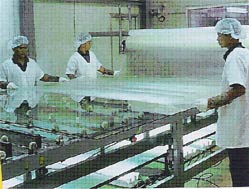Laminated glass is made by sandwiching Poly vinyl butryl (PVB) sheet in between two pieces of glass. Laminated glass offers more safety because when the glass breaks, it keeps sticking on to the PVB sheet in the middle. Apart from safety, laminated glass also insulates sound, protects against UV rays, and even controls the heat when used with a solar control (or solar control thermal insulating) glass or specialized PVB.
The thickness of PVB would be minimum .38 mm and its multiples. Even though the PVB sheet reduces the UV transmission up to 99 %, it does not have any effect on visible light transmission, and hence on the solar or non-solar heat transmission (unless the glass in the combination is solar control or the PVB in itself has such properties). Maximum thickness of glass in the configuration could be up to 24 mm, and for heat strengthened or toughened glass in the configuration, the thickness of PVB would be 1.14 mm (three layers).
Bullet proof glasses are nothing but high configuration laminated glass!
How lamination works?
Even though in simple terms, laminated glass is two glasses stick together with a PVB layer sandwiched in between. But there is actually a chemical bonding working in between. During the manufacturing process of laminated glass under temperature and pressure, there develops a mechanical, as well as a chemical bonding between the PVB and the glass. This adhesive and chemical bondings imparts the true properties to the laminated glass and makes the unit inseparable.
How laminated glass is manufactured?
 The glass of desired thickness is loaded into the laminated glass production line, initially it is cleaned using deionized water. After this, the glass is transferred to a clean room where the PVB is stored, this facility also has an air conditioning system to ensure that the PVB film is stored properly. A clean environment is mandatory for the storage facility as any dust particles sticking on to the film can cause de-lamination.
The glass of desired thickness is loaded into the laminated glass production line, initially it is cleaned using deionized water. After this, the glass is transferred to a clean room where the PVB is stored, this facility also has an air conditioning system to ensure that the PVB film is stored properly. A clean environment is mandatory for the storage facility as any dust particles sticking on to the film can cause de-lamination.
In the clean room, the cleaned glass is placed over the aligning table, over which the film is carefully placed with proper geometrical alignment, after which, with the same precision, the second layer of glass is placed on top. Next, the sandwich is released in the roller which takes it for pressing (to remove air bubbles) and controlled heating (to soften the PVB). Finally, the unit is taken to an autoclave where it attains the form of actual laminated glass. In the autoclave, the unit is heated (100 to 150degree) under controlled pressure (8 to 10bar).
proper geometrical alignment, after which, with the same precision, the second layer of glass is placed on top. Next, the sandwich is released in the roller which takes it for pressing (to remove air bubbles) and controlled heating (to soften the PVB). Finally, the unit is taken to an autoclave where it attains the form of actual laminated glass. In the autoclave, the unit is heated (100 to 150degree) under controlled pressure (8 to 10bar).
Types of laminated glass
PVB lamination being the most common form of lamination, has become a standard for automobile application and also is undoubtedly a safety and security solution. There are other forms of lamination as well, like the Cast Liquid Resin Lamination, and PVC Lamination.
Cast liquid resin lamination is relatively a simple process, in which liquid resin is poured inside the cavity created by two glasses kept close to each other, this unit is then cured under UV light. Even though this process produces results, the unit gives poor quality optical properties and is not considered to be as safe as PVB lamination.
PVC is another form of lamination, and is much cheaper when compared to PVB. Obviously “cheaper” has it’s drawbacks. In a PVC lamination, the film cannot support the glass pieces on breakage, and hence it is not considered to be safe. There are no chemical bonds forming between the film and the glass, as what happens in PVB lamination. There are also possibilities of de-lamination happening due to the absence of chemical bonding.
Reference and Image Courtesy:
http://www.aisglass.com/pvb_laminated.asp
http://auto.howstuffworks.com/car-driving-safety/safety-regulatory-devices/auto-glass2.htm



Thanks for the helpful information this article provided.
Pingback: Your Questions About Glass Laminated
Pingback: Your Questions About Laminated Glass Thickness